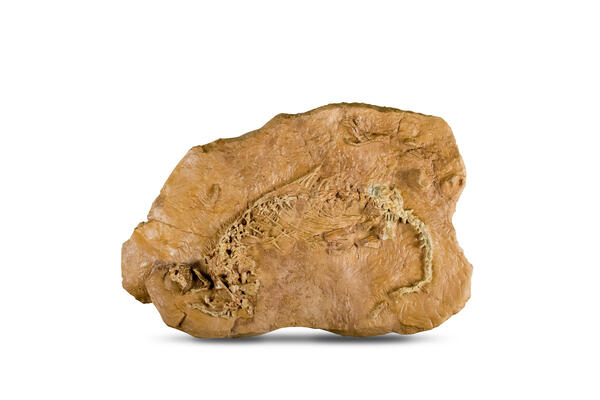Suminia is a herbivorous reptile of a small size, comparable to present-day cats. The total length of its body was not more than 50 cm. It resembled a lizard with a short muzzle, large eyes, and buck teeth like those of rodents. According to its skeleton, Suminia spent a significant part of its life on plants. This species probably lived in large colonies.
The teeth of Suminia were quite large in comparison to the size of the entire body. There were cusps on each tooth and serrations that helped to grind tough food. These creatures mainly fed on leaves, soft shoots, and they could probably catch insects.
Suminia became one of the first terrestrial herbivores that could chew tough food. Before that, animals fed on plants, aquatic vegetation, or dead plants. Notably, they did not chew food but immediately gulped it.
The limbs of Suminia were long and thin; forelimbs were a bit shorter than the hind ones. Wide feet with flexible fingers resembled present-day chameleons’ feet which point to its arboreal lifestyle.
A complete skeleton of Suminia is displayed in the collection of the Natural History Museum of Tatarstan. The skeleton was found in 2009 in the Kirov Region in sand deposits on the banks of the Vyatka River. The skeleton was preserved curved, the left forelimb is in front of the skull, and the left hind limb is bent and placed under the pelvic. The tail is also bent. The wrist of the forelimb was well preserved, and scientists were able to recreate its form.
The first almost complete skeleton of Suminia was found in 1990 in the Kirov Region, near the village of Boroviki. The animal got the Latin name “Suminia getmanovi” after the expedition leader Sumin and paleontologist Getmanov, who discovered the fossils. In the following years, other complete skeletons and individual skulls of Suminia were discovered in the Kotelnich locality. All of them were near the river. According to this fact, scientists concluded that these reptiles lived near the water.
The teeth of Suminia were quite large in comparison to the size of the entire body. There were cusps on each tooth and serrations that helped to grind tough food. These creatures mainly fed on leaves, soft shoots, and they could probably catch insects.
Suminia became one of the first terrestrial herbivores that could chew tough food. Before that, animals fed on plants, aquatic vegetation, or dead plants. Notably, they did not chew food but immediately gulped it.
The limbs of Suminia were long and thin; forelimbs were a bit shorter than the hind ones. Wide feet with flexible fingers resembled present-day chameleons’ feet which point to its arboreal lifestyle.
A complete skeleton of Suminia is displayed in the collection of the Natural History Museum of Tatarstan. The skeleton was found in 2009 in the Kirov Region in sand deposits on the banks of the Vyatka River. The skeleton was preserved curved, the left forelimb is in front of the skull, and the left hind limb is bent and placed under the pelvic. The tail is also bent. The wrist of the forelimb was well preserved, and scientists were able to recreate its form.
The first almost complete skeleton of Suminia was found in 1990 in the Kirov Region, near the village of Boroviki. The animal got the Latin name “Suminia getmanovi” after the expedition leader Sumin and paleontologist Getmanov, who discovered the fossils. In the following years, other complete skeletons and individual skulls of Suminia were discovered in the Kotelnich locality. All of them were near the river. According to this fact, scientists concluded that these reptiles lived near the water.



